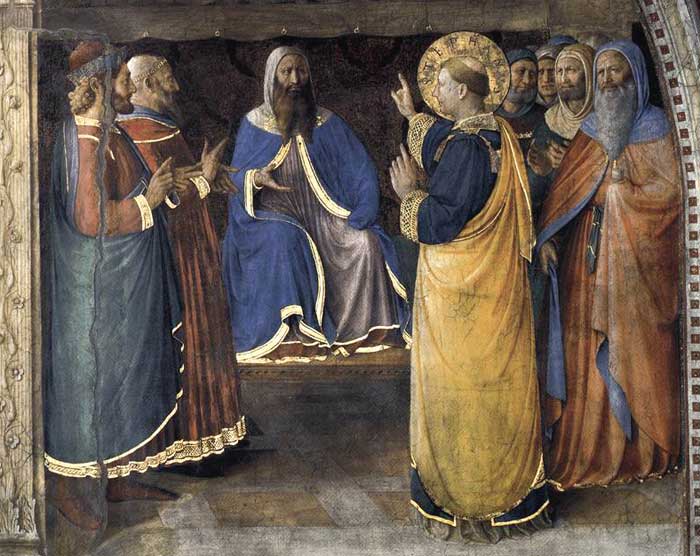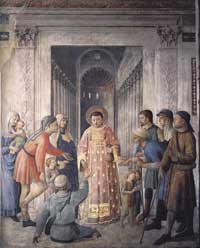 |
|
Fra Angelico, Cappella Niccolina, Palazzi Pontifici, Vatican, View of the chapel |
|
Fra Angelico | Frescoes in the Cappella Niccolina of the Palazzi Pontifici in Vatican (1447-49) |
The Niccoline Chapel (Cappella Niccolina) is a chapel in the Vatican Palace. [1] It is especially notable for its fresco paintings by Fra Angelico (1447–1451) [2] and his assistants, who may have executed much of the actual work. The name is derived from its patron, Pope Nicholas V, who had it built for use as his private chapel.
|
 |
Fra Angelico, St Peter Consacrates Stephen as Deacon (detail), Cappella Niccolina, Palazzi Pontifici, Vatican |
The three walls of the chapel are divided into two registers with stories of Saint Stephen in the lunettes above, and Saint Lawrence below. Stephen was one of the first deacons ordained by Saint Peter in Jerusalem. Fluent in Greek, he ministered to the needs of the Greek widows in the early Christian community. Stephen was thoroughly versed in the scriptures and he fearlessly debated the unconverted Jews in the synagogues of Jerusalem. His vigorous debate with the elders of the Sanhedrin occupies the right half of a lunette in which Fra Angelico depicted in the other half, by contrast, the saint's words being gratefully received by a congregation of women seated under an open sky. Stephen was the first Christian martyr. His preaching infuriated his enemies, who cast him out of the city gates and stoned him to death; a consenting witness on the scene was Saul of Tarsus. In the lower register of each wall are scenes from the life of Saint Lawrence, the Roman martyr of the third century. They represent: his ordination by Saint Sixtus; the pope giving him the treasures of the Church while the imperial soldiers forcibly enter through the door at left; Saint Lawrence's distribution of these treasures to needy widows, orphans, and crippled; the saint's interrogation by the Emperor Decius; a small inset scene of Saint Lawrence converting his jailor; and, finally, his martyrdom on the fiery gridiron. The parallels between the ordinations, ministry, and martyrdoms of the two courageous deacons, Stephen and Lawrence, have been carefully drawn in order to demonstrate the continuity between the early Church of Jerusalem led by Saint Peter and the early Church of Rome guided by the popes. The august basilicas and finely detailed friezes and capitals of the architectural settings evoke one of the principle themes of Nicholas V's papacy: the restoration of the Eternal City to its ancient glory as caput mundi. The imposing gates of Jerusalem in the lunette of Saint Stephen doubtless refer to Nicholas V's construction of new walls in Rome and the aqueduct of the Acqua Vergine. |
||||
Frescoes on the west wall of the Cappella Niccolina Frescoes on the north wall of the Cappella Niccolina Frescoes on the east wall of the Cappella Niccolina
|
||||
 |
 |
|||
| West wall The fresco cycle consists of scenes from the lives of the archdeacons Stephen (lunette) and Lawrence (bottom register) |
North wall The fresco cycle consists of scenes from the lives of the archdeacons Stephen (lunette) and Lawrence (bottom register). On the lunette of the north wall, St Stephen is seen preaching on the left, and on the right engaged in the dispute with the Jews that led to his condemnation. In the bottom register, St Sixtus is entrusting the church treasure to St Lawrence (left) and St Lawrence distributing alms (right, above the entrance door). |
East wall
|
||
| Frescoes on the west wall of the Cappella Niccolina | ||||
|
||||
 |
||||
Fra Angelico, Lunette on the west wall, Cappella Niccolina, Palazzi Pontifici, Vatican, View of the chapel |
||||
The lunette represents two scenes: The Sermon of St Stephen and Dispute before the Sanhedrin.
On the left St Stephen preaches to an array of figures placed throughout the vista of space. To the right, in a chamber which is also embedded in the lefthand scene yet has a different perspective framework, he addresses the council. Here the depth of the picture is truncated by a blank wall hung with a curtain. |
||||
| The fresco cycle consists of scenes from the lives of the archdeacons Stephen (lunette) and Lawrence (bottom register).
On the lunette of the west wall, St Peter, prince of the apostles, is anointing St Stephen, deacon of the church. In the smaller compartment of the lower register, between the two windows, St Sixtus is seen bestowing the same office on St Lawrence. This lunette presents a second scene of St Stephen distributing alms to the poor. The corresponding motif from the life of St Lawrence appears in the right-hand picture compartment of the north wall, above the entry. There are also two original windows on the west wall. |
||||
The fresco cycle consists of scenes from the lives of the archdeacons Stephen (lunette) and Lawrence (bottom register). |
||||
St. Peter Consacrates St. Lawrence as Deacon |
||||
 |
||||
| Fra Angelico, St. Peter Consacrates St. Lawrence as Deacon, Cappella Niccolina, Palazzi Pontifici, Vatican, View of the chapel |
||||
Sixtus II (257-258) had charged archdeacon Lawrence with dispersing the church's wealth to the needy. This deed aroused the ire of Emperor Valerian who had claimed the treasure for himself, and formed the basis for the charges brought against Lawrence and his eventual execution. |
 |
|||
|
||||
St Peter Consacrates Stephen as Deacon |
||||
 |
||||
Fra Angelico, St Peter Consacrates Stephen as Deacon (detail), Cappella Niccolina, Palazzi Pontifici, Vatican |
||||
 |
||||
St Stephen Distributing Alms |
||||
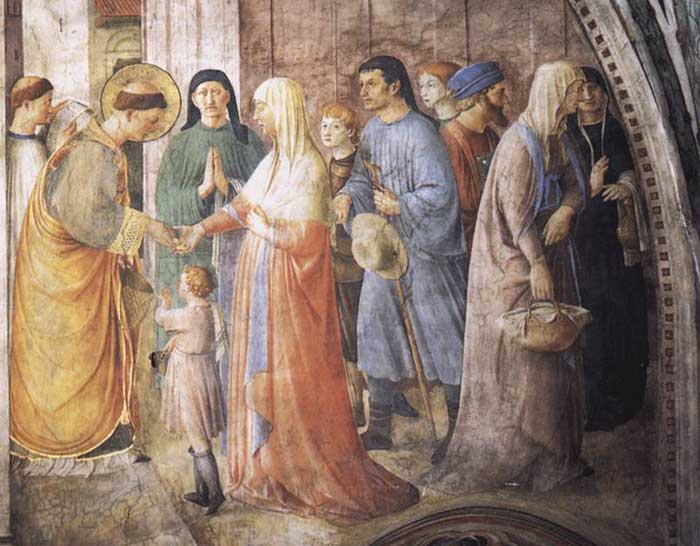 |
||||
Fra Angelico, St Stephen Distributing Alms, Cappella Niccolina, Palazzi Pontifici, Vatican |
||||
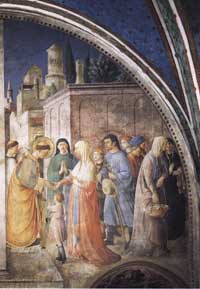 |
||||
Frescoes on the north wall of the Cappella Niccolina The cycles continue on the north wall. In the lunette St Stephen is seen preaching on the left, and on the right engaged in the dispute with the Jews that had led to his condemnation. In the bottom register on the left, St Sixtus is entrusting the church treasure to Lawrence, while in the right-hand compartment St Lawrence is distributing alms (the corresponding motif from the life of St Stephen appears on the west wall). |
||||
Lunette of the north wall |
||||
 |
||||
Fra Angelico, Lunette of the north wall, Cappella Niccolina, Palazzi Pontifici, Vatican, View of the chapel |
||||
The Sermon of St Stephen |
||||
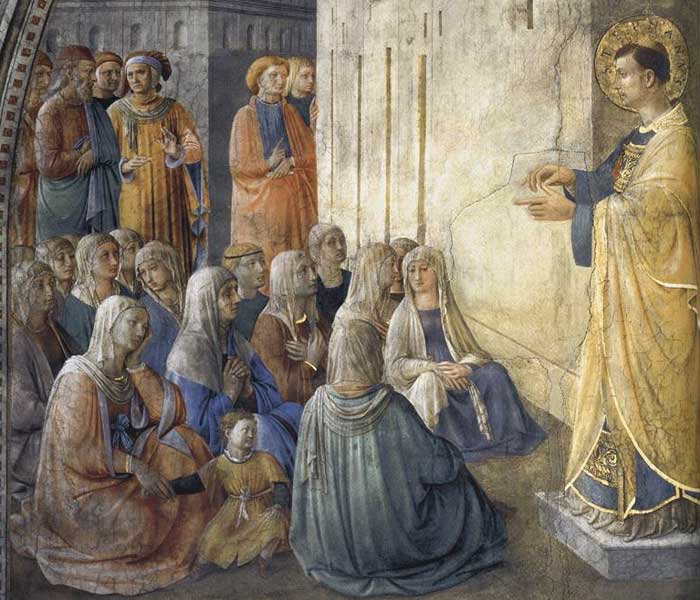 |
||||
Fra Angelico, St. Lawrence on Trial, Cappella Niccolina, Palazzi Pontifici, Vatican |
||||
The Sermon of St Stephen is the left part of the lunette on the north wall. |
 |
|||
Dispute before Sanhedrin |
||||
Fra Angelico, Dispute before Sanhedrin, Cappella Niccolina, Palazzi Pontifici, Vatican |
||||
The Dispute before Sanhedrin is the right part of the lunette on the north wall. |
||||
Below the lunette two scenes are represented: St Sixtus Entrusts the Church Treasures to Lawrence and St Lawrence Distributing Alms.
St Lawrence, a third-century Roman who, like St Stephen, suffered a violent death for his faith, was venerated as one of the most famous martyrs of the city of Rome. This fresco panel is divided in two, without any attempt to give the neighbouring scenes any architectural or spatial cohesion. The architecture employed by Angelico in both scenes is of a distinctly Roman splendour and dignity. The two events from the life of the saint are simply told. They are rich in detail but none is superfluous to the narrative. On the left he kneels to receive the treasures of the Church from Pope St Sixtus II, who is given the features of Angelico's patron, Nicholas V. It has been suggested that the depiction of the two soldiers preparing to break open a bricked-up door, is a reference to Pope Nicholas's decision to declare 1450 a Jubilee Year. On the right, St Lawrence is shown framed in the entrance to a colonnaded basilica of great monumentality. The distant apse further frames and gives emphasis to the saint. He is attended by the poor, blind and lame, and hands money to a legless man in the immediate foreground. His scarlet vestment is scattered with golden flames and hints at his future death by burning. |
||||
St Sixtus Entrusts the Church Treasures to Lawrence |
||||
Fra Angelico, St Sixtus Entrusts the Church Treasures to Lawrence, Cappella Niccolina, Palazzi Pontifici, Vatican |
||||
In 1447, or perhaps earlier, Fra Angelico was in Rome, where he painted the private chapel of Pope Nicholas V with scenes from the lives of St Lawrence and St Stephen, frescoes which sum up the whole trend of his work. They possess a logical realism in their perspective settings, clarity of scale and narrative content, and restraint in their vigour. The colour is limpid, but with sufficient use of chiaroscuro to give substance to the figures; the use of continuous representation is kept to a minimum by the division of the scenes through differences in their architectural setting, but nowhere is the search for realism in the use of lighting effects allowed to destroy the unity of the whole, or the sense of the plane of the wall.
The stories are told with a wealth of circumstantial and colourful detail: for instance the allusion to the Pope's decision to declare 1450 a Jubilee Year is shown by the two soldiers about to break down the walled-up door on the left but even a detail of this kind is never intrusive or merely included for decorative richness, but is at the heart of the narrative. In the early Church, Saint Sixtus was the most highly venerated Pope after St. Peter. His name is included in the first Eucharistic Prayer. Sixtus converted to Christianity as an adult. He served as a deacon in Rome before he was consecrated as Pope on August 30, 257. Sixtus was the Pope for less than a year, before he was martyred. During his short reign he dealt with the controversy of Baptisms performed by heretics. His conclusion was that if a person had a sincere desire to be baptized, he was validly baptized despite the errors of the person performing the sacrament. In the first three centuries of the existence of the Catholic Church, most of the Popes were martyred. Before Constantine issued the Edict of Milan in 313, which granted religious tolerance to Christians, there were ten major persecutions of Christians by the Roman Empire. In 257, the Emperor Valerian directed a major persecution against Bishops, priests and deacons. During this persecution, Christians held their sacred assemblies in subterranean caverns called catacombs. These assemblies were expressly forbidden by Valerian. But Christians chose to obey the law of God, rather than the law of man. Pope Sixtus was seized while offering Mass at the catacombs of Praetextatus along the Appian Way. Sixtus was probably immediately beheaded after his arrest on August 6, 258. Some say that St. Sixtus was beheaded while still seated in the chair from which he had been addressing his flock. Others say that he was taken away for examination and returned to the scene for execution. Two deacons (Felicissimus and Agapitus), and subdeacons (Januarius, Magnus, Stephanus, and Vincentius) were killed on the same day. Four days later St. Lawrence was martyred. According to legend, Sixtus met St. Lawrence on the way to his execution and predicted that Lawrence would follow him in a few days, but the legend cannot be verified. Saint Sixtus was buried at the nearby catacomb of Saint Callistus. Callistus was one of the predecessors of Sixtus who had also been martyred. The Christians enshrined the bloodstained chair, on which Saint Sixtus was beheaded, behind his tomb. |
 |
|||
|
||||
|
||||
Fra Angelico, St. Lawrence giving alms, (detail), Cappella Niccolina, Palazzi Pontifici, Vatican |
||||
In the fresco Saint Lawrence Giving Alms, the artist consciously compares the saint to Christ. Clearly written on the pectoral of his red dalmatic, which is emblazoned with mystical flames, are the letters: JHESVS CHRISTVS. He is shown enclosed within the apse of a superb basilica, the Catholic church, and his heart is superimposed over the place of the altar. Douglas considered this fresco the greatest of all Fra Angelico's works, the fitting climax of his whole career. "It is the complete and final expression in art of both the artistic and religious creeds of some of the best men of the early quattrocento."[2] The touching portrayals of the poor, blind, and maimed in this fresco directly recall Masaccio's great painting, Saint Peter Healing with His Shadow, in the Brancacci Chapel. Indeed, numerous passages in the Chapel of Nicholas V reveal Fra Angelico turning for inspiration to this Florentine antecedent, which was dedicated to the same theme, the Roman papacy. Although critics are wont to praise the correct perspective of the various church naves depicted in these paintings, the relationship of Angelico's figures to this architecture is much the same as in the frescoes of Masaccio and Masolino, a generation earlier. Many of these fine views function mainly as symbolic backdrop. The contrast with the expansive and consistent treatment of space in the San Marco Altarpiece, for example, could hardly be more pronounced, considering the late date. In view of Nicholas V's fascination with paleo-Christian culture, it is likely that Fra Angelico took the opportunity to study the same late classical mosaics that Masaccio had drawn upon for the Tribute Money in the Brancacci Chapel. Fra Angelico's delicate vision appears to have been a bit overwhelmed by the vastness and imposing scale of Rome and its monuments. In order to become more consistent with the most modern style that was then the vogue in Rome, Fra Angelico attempted to imbue his scenes with Roman monumental classicism. The fresco Saint Lawrence Giving Alms, was erraneously attributed to Benozzo Gozzoli. However, it is a work by Fra Angelico with coworkers. |
||||
Frescoes on the east wall of the Cappella Niccolina |
||||
The fresco cycle consists of scenes from the lives of the archdeacons Stephen (lunette) and Lawrence (bottom register).
On the east wall the narratives run parallel. To the left in the lunette St Stephen is being led to his martyrdom, and to the right we see him being stoned to death. In the lower register Lawrence is first condemned by Emperor Valerian, then in the adjacent scene he is martyred by being roasted on a gridiron. Between these is an auxiliary motif, seen through a small window, showing the conversion of St Hyppolitus, the chief jailer. |
||||
Lunette of the east wall |
||||
 |
||||
Fra Angelico, Lunette of the east wall, Cappella Niccolina, Palazzi Pontifici, Vatican |
||||
The lunette represents two scenes: St Stephen being led to His Martyrdom and the Stoning of St Stephen.
Stephen had been blessed by the Apostles and was the first to be ordained as deacon. Accused of blasphemy, he was stoned to death in Jerusalem. According to legend his remains were taken to Rome in the fifth century and buried beside those of St Lawrence. This lunette is divided in two by the monumental city wall which forms a natural part of both the scenes portrayed. The soft hills strewn with collections of towers and houses are in Angelico's familiar landscape style. All lit from the same source, the lunette has a complete spatial unity. On the left St Stephen, having incurred the wrath of the council, is dragged to the city gate and meets his fate outside it as the first Christian martyr. On the right he is portrayed at prayer. Around him are the stones which have bloodied his face; two more bounce off the back of his head; one of his executioners raises another one high, about to strike again, and holds more in his robe. Saul, who was a consenting witness to the execution, is shown, following the details given in the Acts of the Apostles, as a young man holding part of Stephen's clothes which had been laid at his feet by the witnesses. |
||||
|
||||
Fra Angelico, St Stephen being led to His Martyrdom, Cappella Niccolina, Palazzi Pontifici, Vatican |
||||
The scene St Stephen being led to His Martyrdom is the left half the lunette on the east wall. |
||||
Stoning of St Stephen |
||||
Fra Angelico, Stoning of St Stephen, Cappella Niccolina, Palazzi Pontifici, Vatican |
||||
The Stoning of St Stephen, first martyr of Christianity, is the right half the lunette on the east wall. The left half depicts St Stephen being led to his martyrdom. In this scene he is portrayed at prayer following the description that 'he kneeled down, and cried with a loud voice, Lord, lay not this sin to their charge.' (Apostles 8, v. 60). Around him are the stones which have bloodied his face; two more bounce off the back of his head; one of his executioners raises another one high, about to strike again, and holds more in his robe. Saul, who was a consenting witness to the execution, is shown, following the details given in the Acts of the Apostles, as a young man holding part of Stephen's clothes which had been laid at his feet by the witnesses. |
||||
The Condemnation of St Lawrence by the Emperor Valerian |
||||
Fra Angelico, Condemnation of St Lawrence by the Emperor Valerian, Cappella Niccolina, Palazzi Pontifici, Vatican |
||||
The Condemnation of St Lawrence by the Emperor Valerian is the left half the fresco below the lunette on the east wall. The right half depicts the martyrdom of St Lawrence. The two are linked by the cornice which, although it changes in its detailing, is essentially common to both scenes.
The composition of Condemnation of St Lawrence by the Emperor Valerian owes much to Angelico's earlier sacra conversazione. The wall broken into sections by pilasters, hung with a rich ornamental curtain and incorporating a lofty architectural throne, is familiar from the Annalena altarpiece of a couple of years before. Various soldiers and city worthies stand in a circle before the Emperor, helping to create a sense of depth without the assistance of any converging orthogonals in the foreground. |
||||
Martyrdom of St Lawrence |
||||
Fra Angelico, The Martyrdom of St Lawrence, Cappella Niccolina, Palazzi Pontifici, Vatican |
||||
The vault |
||||
| In the vaults of the chapel, the Evangelists are suspended on clouds, amid the starry blue heavens. Their luminous faces and pale garments seem suffused with incandescent light as they compose the Gospels of Christ's life. |
||||
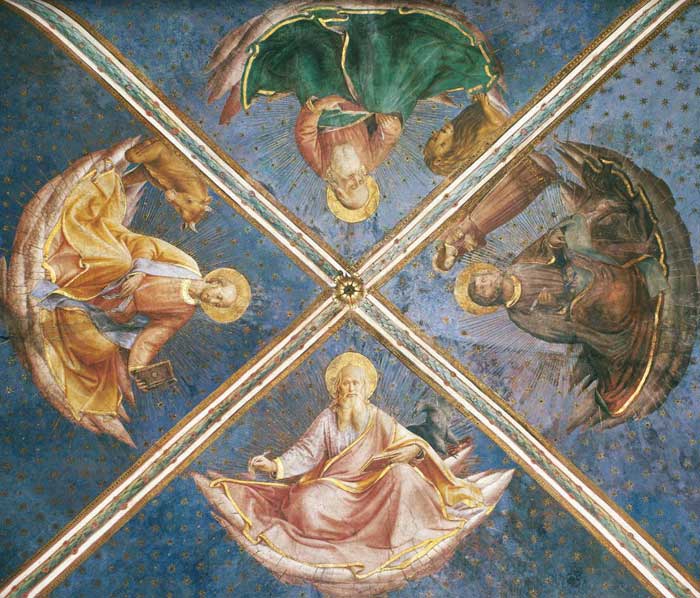 |
||||
Fra Angelico, The vault, Cappella Niccolina, Palazzi Pontifici, Vatican |
||||
The vault of the rectangular chapel is divided by ribbing into four vanes, one for each of the four Evangelists. The restoration has revealed the superb quality of these four figures, especially the Saint Luke, shown with his attribute of an ox, who is rendered with refined tints and miniaturist delicacy more to be expected in a painting on panel than in a wall fresco. The Evangelists are shown against an azure dome of heaven made precious by golden stars. It was traditional to represent Saints Matthew, Mark, Luke, and John on the vault of a chapel as a sign of the divine origin of their Gospels. In the four corners of the chapel Fra Angelico painted standing figures of eight saints and doctors of the Church, whose authority thus descends directly from God. The contributions made by Benozzo Gozzoli and by Fra Angelico's other assistants in the Chapel of Nicholas V have generally been assigned too much importance. Many of the heads ascribed to Gozzoli in the past can now be seen, thanks to the restoration still in progress, to have been painted by the master. Moreover, it seems clear that Gozzoli was employed to execute Fra Angelico's designs and not to impress his own personality on any part of the program. |
||||
Address: Viale Vaticano, Roma |
||||
This page uses material from the Wikipedia article Niccoline Chapel, published under the GNU Free Documentation License. |
||||
Beato Angelico andn Benozzo Gozzoli in Orvieto(1447-48)
|
||||
| |
||||
Fra Angelico e Benozzo Gozzoli, Volta, Cristo giudice, Cappella di San Brizio, Duomo di Orvieto
|
I Profeti, dettaglio della Vela dei profeti, affrescoi di Beato Angelico e Benozzo Gozzoli (1447-48) volta della Cappella di San Brizio, Duomo di Orvieto
|
Fra Angelico, Volta, Sedici profeti (dettaglio), Cappella di San Brizio, Duomo di Orvieto
|
||
|
||||
|
||||
Podere Santa Pia, mystic holiday home in the heart of the Tuscan Maremma
|
Casa Vacanze Podere Santa Pia, Castiglioncello Bandini, Toscane
|
Colline sotto Podere Santa Pia con ampia vista sulla Maremma Grossetana
|
||
| |
|
|||
Pools in a natural area, a dive into the heart of Tuscany
|
A beautiful spring morning by the pool, a natural jewel nestled amidst the verdant Tuscan hill
|
The night pool at Podere Santa Pia exudes a hypnotic sense of purity
|
||
 |
||||
Podere Santa Pia, situated in a particularly scenic valley | Impressions and reviews |
||||
 |
||||
San Marco in Florence |
Montalcino |
Villa La Foce |
||
The Vatican Museums The Vatican Museums contain a vast store of artworks which range from the ancient to the contemporary, including the world famous Sistine Chapel. Touring the Vatican Museums can easily take two hours or more, so it is imperative that you have an action plan when you visit. Here is a list of the top attractions to look for when you visit the Vatican Museums. For a complete list, visit the Vatican Museums website. 1. The Sistine Chapel The Sistine Chapel is one of the main attractions to visit in Vatican City. The highlight of a visit to the Vatican Museums, the famous chapel contains ceiling and altar frescoes by Michelangelo and is considered one of the artist's greatest achievements. But the chapel contains more than just works by Michelangelo; it is decorated from floor to ceiling by some of the most famous names in Renaissance painting. The Sistine Chapel is the last room that visitors see when touring the Vatican Museums. The grand chapel that is known around the world as the Sistine Chapel was built from 1475-1481 at the behest of Pope Sixtus IV (the Latin name Sixtus, or Sisto (Italian), lending its name to "Sistine"). The monumental room measures 40.23 meters long by 13.40 meters wide (134 by 44 feet) and reaches 20.7 meters (about 67.9 feet) above the ground at its highest point. The floor is inlaid with polychrome marble and the room contains an altar, a small choristers' gallery, and a six-paneled marble screen that divides the room into areas for clergy and congregants. There are eight windows lining the upper reaches of the walls. Michelangelo's frescoes on the ceiling and the altar are the most famous paintings in the Sistine Chapel. Pope Julius II commissioned the master artist to paint these parts of the chapel in 1508, some 25 years after the walls had been painted by the likes of Sandro Botticelli, Ghirlandaio, Perugino, Pinturrichio, and others. 2. The Raphael Rooms Raphael worked on the mesmerizing frescoes in these four rooms – the apartments of Pope Julius II – while Michelangelo was painting the Sistine Chapel. The paintings include several significant scenes from Christian history. The most famous room of all is the Room of the Segnatura, in which Raphael painted The School of Athens, a scene that incorporates the likenesses of Raphael's artistic contemporaries, such as Leonardo da Vinci and Michelangelo. 3. The Borgia Apartments The artist Pinturicchio painted the rich frescoes in the Borgia Apartments, the area on the first floor where Pope Alexander VI lived. The rich, colorful frescoes depict scenes from Egyptian and Greek mythology and speak to lavishness of the Vatican Palace. 4. The Gallery of Maps This incredible hall has maps frescoed on both walls showing various parts of Italy from the 16th century. These historically significant frescoes of the Italian cities, the countryside, and geographical features, such as the Apennine Mountains and the Tyrrhenian Sea, are a joy to inspect, as is the gallery's sumptuously decorated coffered ceiling. 5. The Cappella Nicolina Some of the most beautiful and vibrant 15th century frescoes, painted by Fra Angelico and Benozzo Gozzoli, are in the diminutive Niccoline Chapel. Named for Pope Nicholas V, who worshipped here, this chapel is located in one of the oldest parts of the papal palace. 6. Greek and Roman Antiquities The Pio-Clementine and the Gregorian Profane Museums are dedicated to treasures of antiquity. Highlights include the Apollo del Belvedere, "a supreme ideal" of classical art; the Laocoön, a large marble composition from 1st century A.D.; the Belvedere Torso, a Greek sculpture from the 1st century B.C.; the Discus Thrower, a 5th century B.C. representation of an discus athlete in movement; and a collection of Roman mosaics. |
||||


